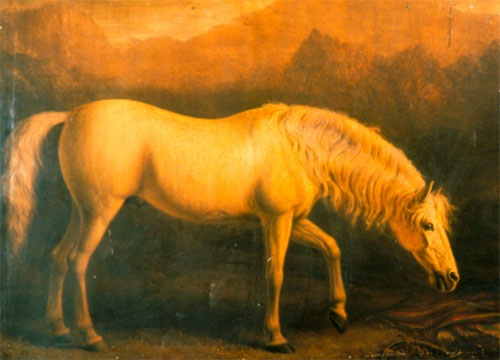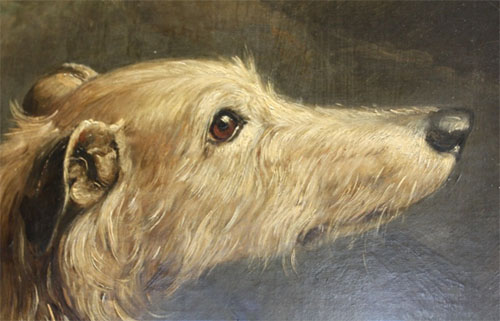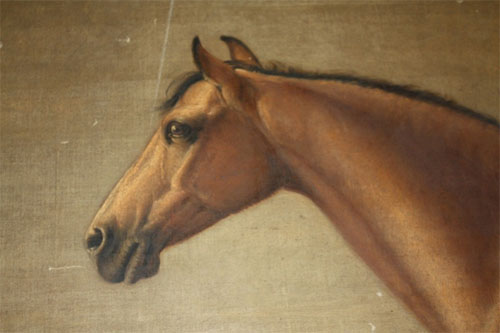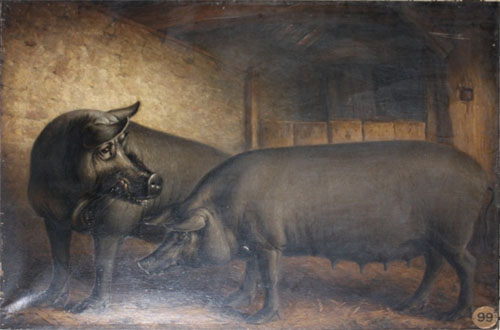Fiona Salvesen Murrell is studying William Shiels, R.S.A. (1783-1857); identity, scientific enquiry, and the development of art institutions in Britain and North America. In three parts she tells us about the work of William Shiels and the collection held at National Museums Scotland. In part 1 Fiona looks at how she came to start researching William Shiels. In part 2 find out about the artist and his work and in part 3 discover the surviving works. Visit the National Museum of Rural Life, East Kilbride to see some of Shiels’s paintings for yourself.
At home and overseas
The range of animals depicted by Shiels encompasses both British and foreign livestock. Sixteen examples of the latter were included as Professor David Low [1], who commissioned the paintings, felt these animals might be of use in bringing beneficial qualities to the native breeds.
![Old English Black horse William Shiels, Old English Black Horse, ‘Old Blacklegs’ . This horse was bred by Mr Broomes at Ormiston, Derby. Low described; ‘Old Blacklegs’ as ‘living in 1834, and then 36 years old; [he was] descended in a direct line from Bakewell's 'Black Horse', the ancestor of many of the finest of the old dray-horses of London. This race of heavy horses is reared extensively in the midland counties, from Lincolnshire to Staffordshire. The individuals are usually of great strength, but without corresponding action.](https://blog.nms.ac.uk/app/uploads/2012/11/horse.jpg)

Domestic animals
Low’s writings and fifty-six of Shiels’ paintings were published in two luxurious volumes in 1842: The Breeds of the Domestic Animals of the British Islands. Shiels’ paintings had been copied by William Nicholson [2], in reduced watercolour versions so that Thomas Fairland [3] could create the hand-coloured lithographic plates in the book. The plates were accompanied by lengthy text on each breed under divisions of type: Horses, Cattle, Sheep, Hogs, and Goats.

The French Government was so impressed with the book that they immediately ordered it to be translated into French. It was re-issued in Britain in 1845, in a much smaller edition, without the colour plates, and with the added title With Observations on the Principles and Practise of Breeding, it was further revised and reissued in 1853.
The Museum of Agriculture and the livestock portrait collection
The Museum of Agriculture was unfortunately housed in dark and damp basement rooms in the Old College of the University of Edinburgh, on the corner of Chambers Street and West College Street. The collections, which included a vast array of models of agricultural implements, machinery, and farm buildings; soil, plant, seed specimens and so on, all suffered as a result, even whilst Shiels was still working on completing the commission. As the University was struggling for funds, the paintings and other items deteriorated quite severely.

In the late 1960s, thirty-five of the remaining pictures were transferred to National Museums Scotland and during the 1980s and 1990s twelve were conserved. The University retains six paintings and nearly all the rest have disappeared. At some point prior to the collection coming to National Museums Scotland, someone cut many pictures off their stretchers and did this in a way which damaged a number severely, so some portraits are missing tips of the animal’s face or backside and some were cut in half, thus it is a difficult, but not impossible, job to repair and conserve them.

